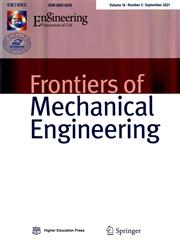主动冷却对丝弧加成低碳钢组织和力学性能的影响
IF 4
2区 工程技术
Q1 ENGINEERING, MECHANICAL
引用次数: 2
摘要
金属的增材制造(AM)吸引了人们的注意,因为它可以在一个步骤中生产复杂的结构,而无需特定的零件工具。线弧增材制造(WAAM)是一种基于焊接的逐层沉积金属的方法,由于其操作成本低、可用于大规模零件制造以及易于操作而越来越受欢迎。本文介绍了用基于MIG的混合WAAM系统制作圆柱形低碳钢(ER70S-6)试样的方法。实现了一种用于主动冷却基板的机制。沉积参数保持不变,以评估主动冷却对沉积质量、道次间冷却时间和内部缺陷的影响。在没有主动冷却装置的情况下制造的圆柱形样品上可以看到表面和体积缺陷。进行缺陷量化和相位分析。在所有样品中形成的主要相是α-铁。主动冷却的沉积横截面显示,不完全熔合或孔隙率降低了99%,沉积后60秒测得的温度平均比未冷却的温度低235°C。微观结构分析揭示了主动冷却沉积沿构建方向的均匀性,但在没有冷却的情况下微观结构不均匀。在所有情况下,硬度从第一层到最后一层降低了大约22HV。属性变化可归因于各自的处理策略。目前的研究表明,主动冷却可以减少生产时间和孔隙率,同时保持沿构建方向的均匀微观结构。这种方法有望在未来几天提高WAAM加工零件的可靠性。本文章由计算机程序翻译,如有差异,请以英文原文为准。
Influence of active cooling on microstructure and mechanical properties of wire arc additively manufactured mild steel
Additive manufacturing (AM) of metals attracts attention because it can produce complex structures in a single step without part-specific tooling. Wire arc additive manufacturing (WAAM), a welding-based method that deposits metal layer by layer, is gaining popularity due to its low cost of operation, feasibility for large-scale part fabrication, and ease of operation. This article presents the fabrication of cylindricalshaped mild steel (ER70S-6) samples with a gas metal arc (MIG)—based hybrid WAAM system. A mechanism for actively cooling the substrate is implemented. Deposition parameters are held constant to evaluate the impact of active cooling on deposition quality, inter-pass cooling time, and internal defects. Surface and volume defects can be seen on the cylindrical sample fabricated without an active cooling setup. Defect quantification and phase analysis are performed. The primary phase formed was α-iron in all samples. Actively cooled deposition cross section showed a 99% decrease of incomplete fusion or porosity, with temperature measured 60 s after deposition averaging 235°C less than non-cooled. Microstructural analysis revealed uniformity along the build direction for actively cooled deposition but non-uniform microstructures without cooling. Hardness decreased by approximately 22HV from the first layer to the final layer in all cases. Property variation can be attributed to the respective processing strategies. The current study has demonstrated that active cooling can reduce production time and porosity while maintaining uniform microstructure along the build direction. Such an approach is expected to enhance the reliability of WAAM-processed parts in the coming days.
求助全文
通过发布文献求助,成功后即可免费获取论文全文。
去求助
来源期刊

Frontiers of Mechanical Engineering
Engineering-Mechanical Engineering
CiteScore
7.20
自引率
6.70%
发文量
731
期刊介绍:
Frontiers of Mechanical Engineering is an international peer-reviewed academic journal sponsored by the Ministry of Education of China. The journal seeks to provide a forum for a broad blend of high-quality academic papers in order to promote rapid communication and exchange between researchers, scientists, and engineers in the field of mechanical engineering. The journal publishes original research articles, review articles and feature articles.
 求助内容:
求助内容: 应助结果提醒方式:
应助结果提醒方式:


